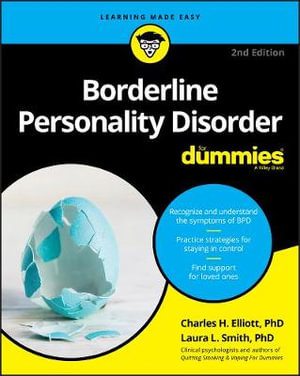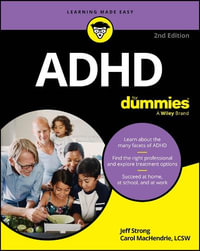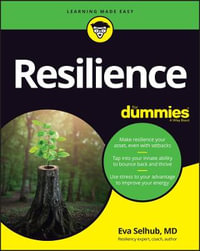
Borderline Personality Disorder For Dummies
2nd edition
By: Charles H. Elliott, Laura L. Smith
Paperback | 23 October 2020 | Edition Number 2
At a Glance
416 Pages
24 x 19 x 2
Paperback
Limited Stock Available
RRP $41.95
$29.80
29%OFF
or 4 interest-free payments of $7.45 with
When will this arrive by?
Borderline personality disorder (BPD) is an extremely serious-and often seriously neglected-condition. Despite around 4 million diagnoses in the USA, BPD has attracted lower funding and levels of clinical concern than more "popular" conditions such as bipolar disorder. But there's no need to lose hope!
Borderline Personality Disorder For Dummies, 2nd Edition was written to bridge this gap and help sufferers learn how to break the cycle to lead a full and happy life.
BPD impacts the way you think and feel about yourself and others and can cause long-term patterns of disruptive relationships and difficulties with self-control. It often results from childhood abuse or neglect, as well as from genetic or brain abnormalities-particularly in areas of the brain that regulate emotion, impulsivity, and aggression. Knowing how it works means we know how to manage it, and Borderline Personality Disorder For Dummies-written in a friendly, easy-to-follow style by two leading clinical psychologists-is packed with useful techniques to do just that: from identifying triggers to finding the right care provider.
- Get a compassionate, actionable understanding of the symptoms and history of BPD
- Acquire techniques to identify and halt damaging behaviors
- Evaluate providers and the latest therapies and treatments
- Set goals and habits to overcome problems step-by-step
Introduction 1
About This Book 1
Foolish Assumptions 2
Icons Used in This Book 3
Beyond the Book 3
Where to Go from Here 3
Chapter 1: Exploring Borderline Personality Disorder 7
Breaking Down Borderline Personality Disorder 8
Unpredictable relationships 9
Acting without thinking 9
Volatile emotions 10
Confusing thoughts 10
Exploring the Origins of BPD 11
Counting the Costs of BPD 12
Health costs 12
Financial and career-related costs 13
The toll on family and friends 14
Treating BPD 15
Psychotherapy 15
Medication 16
Relating to People Who Have BPD 16
Chapter 2: Defining Personality to Understand BPD 19
Characterizing Personality 20
Differentiating Healthy from Unhealthy 20
Openness: Seeking new experiences 22
Flexibility: Rolling with the punches 22
Emotional regulation: Controlling what you express 23
Ability to delay gratification: Controlling impulses 24
Conscientiousness: Responsible and reliable 24
Interpersonal effectiveness: Having good relationships 25
Emotional resiliency: Bouncing back from tough breaks 25
Self-acceptance: Seeing yourself as you really are 26
Accurate perception of reality: Seeing the world as it is 26
Moderation: Avoiding extremes 27
Chapter 3: Describing BPD 29
The Nine Symptoms of BPD 30
1 Sensation seeking (impulsivity) 30
2 Self-harm 31
3 Roller coaster emotions 31
4 Explosiveness 31
5 Worries about abandonment 32
6 Unclear and unstable self-concept 32
7 Emptiness 32
8 Up-and-down relationships 32
9 Dissociation: Feeling out of touch with reality 33
Diagnosing BPD: Like Ordering from a Chinese Menu 33
High or Low Functioning 38
BPD Over the Life Span 38
Other Personality Disorders 39
The odd and eccentric 40
The dramatic and erratic 43
The anxious and fearful 46
Emotional Disorders That Accompany BPD 50
Anxiety 51
Trauma and stressor-related disorders 52
Obsessive-compulsive and related disorders 53
Depressive disorders 54
Bipolar and related disorders 54
Other emotional disorders 56
Chapter 4: Exploring the Root Causes of BPD 59
Beginning with Biology 60
Genetics 60
Brain chemistry and functioning 61
Psychological Factors 62
Problematic parenting 63
Abuse and trauma 66
Separation and loss 67
Disorganized and disrupted families 67
Social and Cultural Influences 68
The neighborhood 69
Friends and peers 70
The teen years 70
Social media 70
Cultural factors 71
Mixing and Matching Risk Factors 74
Biological and psychological factors 75
Biological and social influences 76
Psychological and social causes 76
A full biopsychosocial mix 77
Part 2: The Major BPD Symptoms 79
Chapter 5: Sensation Seeking and Self-Harm: The Impulsivity of BPD 81
Living Dangerously: Impulsive Behavior 82
Hurting for Help 84
Types of self-harming acts 84
Why hurt yourself? 85
Suicide: Seeking the Ultimate Escape 88
A cry for help or an attempt at revenge? 89
Who’s at risk? 89
Chapter 6: Explosive Feelings and Moods 91
Emotions 101 91
Primitive emotions 93
Thoughtful emotions 95
Emotions — Borderline Style 95
Struggling to recognize and express emotions 97
Having emotions about emotions 98
Chapter 7: Missing Persons: Identity Problems and BPD 99
The Concept of Identity 100
What is identity? 100
How does identity develop? 102
Borderline Identity: Unstable and Fragile 104
Waffling identities 105
Worries about identity 106
Chapter 8: Perceiving, Understanding, and Relating to Others 107
Standing in Other People’s Shoes 108
Understanding other people 108
Seeing yourself through other people’s eyes 110
Causing unintended hurt 111
Busting through Boundaries 113
Disrespecting partners and lovers 114
Slighting friends and co-workers 115
Straining relationships with helpers 115
Riding roughshod over kids 116
Chapter 9: BPD and Extreme Thinking 117
Understanding How You See the World 117
How schemas develop 118
Types of schemas 119
Why schemas are hard to change 120
BPD Schemas: No Middle Ground 121
Self-concept schemas 121
Relationship schemas 124
World schemas 127
Chapter 10: Slipping Away from Reality 131
Discovering Dissociation 132
Feeling Paranoid or Delusional 134
Having Hallucinations 135
When You Have BPD and Feel Crazy 137
Part 3: Making the Choice to Change 139
Chapter 11: Researching and Choosing BPD Treatments 141
Exploring BPD Treatment Settings 142
Working individually with a therapist 142
Giving groups a chance 142
Spending more time in treatment: Partial hospitalization 143
Needing more care: Inpatient psychiatric wards 143
Combining and changing treatments 144
Researching the Treatment Strategies That Work for BPD 144
Dialectical behavior therapy (DBT) 145
Mentalization-based therapy (MBT) 145
Transference-focused psychotherapy (TFP) 146
Cognitive therapy 146
Schema therapy 147
Transdiagnostic treatment 148
Metacognitive therapy (MCT) 148
Systems training for emotional predictability and problem solving (STEPPS) 148
Acceptance and commitment therapy (ACT) 149
Compassion focused therapy (CFT) 149
Medication 149
Common factors in therapies 149
Choosing a Mental Health Professional 150
Primary healthcare providers 152
Psychologists 153
Psychiatrists 153
Counselors 154
Marriage and family therapists 154
Psychiatric nurses 155
Social workers 155
Starting Treatment 156
Evaluating your therapy 156
Giving therapy some time 157
Chapter 12: Breaking Through Barriers to Change 159
Overcoming the Fear of Change 160
Losing who you are: It’s not going to happen 161
Opening up: No need for cold feet 161
Dreading even more loss: Try not to test the ones who want to help 162
Fearing treatment: Don’t let therapy myths hold you back 162
Looking at fears of change in action 164
Taking Charge and Giving Up the Victim Role 165
Ending the blame game 165
Thinking like a victim: It doesn’t help 166
Finding forgiveness and coping 167
Stop Procrastinating 167
Dismantling excuses 167
Debating the decision 169
Getting Comfortable with the Process of Change 171
Chapter 13: Explaining BPD to Others 173
Deciding Whether and Whom to Tell 174
The benefits and costs of telling 174
Figuring out whom to tell 176
Deciding What to Tell 180
Educating yourself 180
Deciding how much to say 181
Telling Your Story Effectively 184
Chapter 14: Taking Care of Yourself 187
Dealing with Stress 187
Reviewing how stress affects health 188
Managing and reducing stress 189
Taking Better Care of Your Body 190
Revising your diet 191
Energizing with exercise 192
Getting enough sleep 192
Taking healthy actions 195
Finding More Time for Yourself 196
Part 4: Treatments for BPD 197
Chapter 15: Inhibiting Impulsivity 199
Increasing Your Awareness of Impulsive Behavior 200
Write down your impulsive acts 200
A case study of working on impulsiveness 202
Putting the Brakes on Impulsivity 206
Putting time on your side 206
Putting off your impulses 208
Doing something different 209
Fire drilling 209
Seeking Healthier Alternatives 211
Chapter 16: Calming the Storms Within 213
Putting a Name Tag on Feelings 214
Understanding the thought-feeling connection 214
Practicing emotional regulation 215
Forbidding Feelings from Ruling Over Thoughts 216
Doing the opposite of what you feel 217
Calming down with coping self-statements 218
Relaxing and Practicing 219
Making muscles relax 219
Soothing through the senses 223
Visualizing calm 224
Discovering Meditation 225
Benefits of meditation 225
How to meditate 226
Types of meditation 227
Meditation myths 229
Acquiring Acceptance 230
Discovering your observant mind 231
Playing with your judgmental mind 233
Chapter 17: Creating an Identity 235
Clarifying What’s Important in Your Life 236
Finding your personal priorities 236
Creating a personal life mission statement 239
Finding Forgiveness and Self-Compassion 242
Forgiving yourself first 242
Going from self-forgiveness to self-compassion 243
Fumbling to forgive others 244
Chapter 18: Putting Yourself in Other People’s Shoes 247
Understanding Others’ Points of View 248
Projecting: Thinking others feel what you feel 248
Practicing perspective taking 250
Noticing Your Impact on Others 255
Decreasing Defensiveness 255
Taking the “I” out of interactions 256
Putting a friend on your side 257
Musing over defusing 257
Getting Along Better 258
Listening 259
Giving compliments 259
Pillowing rather than pummeling 260
Chapter 19: Finding Shades of Gray: Changing Problematic Core Beliefs 261
Schema Busting Strategies 262
Recognizing the effects of schemas on your feelings 263
Exorcising problematic childhood schemas 266
Tabulating a cost-benefit analysis 268
Adopting Adaptive Schemas 271
Taking the direct approach 272
Staying on track with flash cards 273
Chapter 20: Considering Medication for BPD 277
Putting Medications on Trial 277
Getting Help from Medications 279
Considerations for taking medication 280
Precautions to consider 280
Surveying the Medicine Cabinet 282
Antidepressants 282
Neuroleptics 285
Mood stabilizers 286
Anti-anxiety medications (minor tranquilizers) 286
Problems with the Polypharmacy Strategy 286
Making the Medication Decision 287
Part 5: Advice for People Who Care 289
Chapter 21: What to Do When Your Partner Has BPD 291
Understanding Borderline Behaviors within Relationships 292
Going to extremes 292
Giving you the silent treatment 293
Gaslighting 295
Initiating isolation 296
Shaking up the present 297
Expressing entitlement 297
Acting impulsively 298
Feeling rejected and abandoned 299
Misinterpreting threats to self-esteem 300
Staying Safe: Emotionally and Physically 301
Dealing with your partner’s self-abuse 302
Knowing what to do when you’re the recipient of abuse 302
Walking Away from BPD 304
Debating the decision 304
Leaving abusive relationships if you decide to do so 306
Leaving nonabusive relationships if you decide to do so 308
Remaining in a Relationship 309
What does love have to do with it? 309
Hanging in for the long haul 310
Chapter 22: Befriending People with BPD 311
Recognizing Warning Signs of BPD 312
Determining When You’re Vulnerable to BPD Influence 315
Detecting Serious Symptoms 316
Handling Friends with BPD 317
What you can do 317
What you can’t do 319
Dealing with Dangerous Situations 321
Ending a BPD Relationship 322
Making your exit 322
Wrangling with guilt 323
Sticking with a Friend Who Has BPD 324
Chapter 23: Parenting Children at Risk for BPD 325
Heeding Early Warning Signs 326
Identifying problem behaviors 327
Pursuing a diagnosis 328
Looking at Risk Factors 329
Finding the Right Help 330
Loving Tough 332
Supporting without fostering 332
Setting limits 333
Dealing with a dangerous or out-of-control child 335
Managing screen time and social media 336
Taking Care of Everyone Else — Including Yourself 337
Parenting Adult Kids with BPD 338
Chapter 24: Advice for Adult Children of BPD Parents 339
Mourning the Perfect Childhood 340
Understanding the impact of BPD on children 340
Reviewing your relationship with your parent 342
Moving on with Your Life 344
Setting boundaries 344
Soliciting support 346
Becoming resilient 346
Chapter 25: Advice for Therapists of People with BPD 347
Detecting BPD in the Early Stages of Therapy 348
Maintaining Objectivity 350
Keeping your therapist ego on the shelf 351
Keeping therapist expectations within bounds 352
Understanding Boundaries 353
Dealing with Boundaries 354
Taking Care of Yourself 358
Part 6: The Part of Tens 361
Chapter 26: Ten Quick Ways to Settle Down 363
Breathing Away Distress 363
Chilling Your Hot Emotions 364
Picking Up Your Pace 364
Massaging Away the Blues 365
Surfing for Distraction 365
Reading (or Listening to) a Great Book 365
Mellowing Out in a Movie 366
Playing to Improve Your Mood 366
Phoning a Friend 366
Getting Outside 367
Chapter 27: Ten Ways to Say You’re Sorry 369
Saying the Words Out Loud 369
Asking for Forgiveness 370
Running an Errand 370
Sending Flowers 371
Sending a Card 371
Doing a Chore 371
Writing Your Thoughts 371
Finding a Poem 372
Sending a Small Gift 372
Making Amends: Giving or Volunteering 372
Chapter 28: Ten Things You Shouldn’t Do 375
Expect Quick Fixes 375
Stay Stuck 376
Choose Chiropractic Medicine 376
Stick Pins and Needles 376
Find a Life Coach 377
Fill Up Emptiness with Food or Drink 377
Try Too Hard 377
Gaze at Crystals 378
Get the Wrong Therapy 378
Hope That Medications Will Cure BPD 379
Appendix: Resources for You 381
Index 385
ISBN: 9781119714309
ISBN-10: 1119714303
Series: For Dummies
Published: 23rd October 2020
Format: Paperback
Language: English
Number of Pages: 416
Audience: General Adult
Publisher: John Wiley & Sons Inc (US)
Country of Publication: GB
Edition Number: 2
Dimensions (cm): 24 x 19 x 2
Weight (kg): 0.77
Shipping
| Standard Shipping | Express Shipping | |
|---|---|---|
| Metro postcodes: | $9.99 | $14.95 |
| Regional postcodes: | $9.99 | $14.95 |
| Rural postcodes: | $9.99 | $14.95 |
How to return your order
At Booktopia, we offer hassle-free returns in accordance with our returns policy. If you wish to return an item, please get in touch with Booktopia Customer Care.
Additional postage charges may be applicable.
Defective items
If there is a problem with any of the items received for your order then the Booktopia Customer Care team is ready to assist you.
For more info please visit our Help Centre.
You Can Find This Book In
This product is categorised by
- Non-FictionMedicineMedicine in GeneralHealth Systems & ServicesMental Health Services
- Non-FictionPsychology
- Non-FictionMedicineOther Branches of Medicine
- Non-FictionSelf-Help, Personal Development & Practical AdviceHow-toFor Dummies BooksHumanities Psychology Reference
- BargainsNon-Fiction BargainsMedicine Bargains
- BargainsNon-Fiction BargainsFamily & Relationships Bargains
- BargainsNon-Fiction BargainsBusiness, Finance & Self Help
























